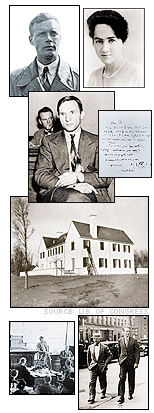Lindbergh Kidnapping

The crime that shocked the nation
by David Johnson
 Related Links |
Called "the biggest story since the Resurrection," by journalist H. L. Mencken, the kidnapping and murder of Charles A. Lindbergh's infant son stunned America in the early 1930s.
Known as "The Lone Eagle," Lindbergh made the first solo, non-stop flight across the Atlantic. Two years later he married Anne Spencer, daughter of a former U.S. Ambassador to Mexico. He taught Anne to fly, and they later flew across the northern Pacific to Asia, pioneering a route still used today.
In an effort to find privacy, the couple built a $50,000, 20-room stone mansion in the secluded Sourland Mountains outside Princeton, N.J.
Child Kidnapped
On the evening of March 1, 1932, the Lindberghs were spending a quiet evening at home. Betty Gow, a Scottish nurse, was looking after 20-month-old Charles, Jr. Two servants were also in the house.
At around 10 pm, the nurse discovered the baby was not in his second-floor room. A note demanding $50,000—a huge sum at the time—was found in his place. Lindbergh searched outside with a gun but to no avail.
No fingerprints were found, but a homemade ladder was discovered outside.
A Massive Search
State police Col. Norman Schwarzkopf (whose son would later lead the Persian Gulf War) led the massive search that followed.
The case generated enormous publicity and police received thousands of tips and offers of help. Dr. John (Jafsie) Condon placed ads in a Bronx newspaper seeking contact with the kidnappers. Not long afterwards, Condon was sent the pajamas the Lindbergh baby was wearing when he was kidnapped, along with ransom notes.
The Ransom Delivered
On April 2, Lindbergh and Condon met a man claiming to be a kidnapper in a Bronx cemetery. Condon gave the man the ransom, $50,000 in marked U.S. gold certificates, which were to be withdrawn from circulation in 1933, making them hard to dispose of casually.
The kidnapper produced a note saying Charles, Jr., was on a boat along the Massachusetts coast. Although Lindbergh flew over the region for days, he never located the boat in question.
In May, a truck driver discovered the remains of the Lindbergh baby in the woods along a road near the Lindbergh home.
Suspicious Motorist
In 1934, a gas station attendant in the Bronx, N.Y., got suspicious when a motorist paid for gasoline with a gold certificate. He noted the man's license plate number and notified police.
The car belonged to an illegal German immigrant named Bruno Richard Hauptmann. Police discovered $14,000 of the ransom money in Hauptmann's house, and arrested him.
It turned out that Hauptmann had served a three-year prison sentence in Germany for burglary. He had used a ladder to enter a second-floor window. Hauptmann had fled to the U.S. to avoid another trial on charges of possessing stolen tools. Although he had recently quit his job as a carpenter, Hauptmann was living well and had been investing in the stock market.
"Trial of the Century"
Thousands of people flooded tiny Flemington, N.J., for the trial. The Hearst newspapers paid for a leading defense attorney, Edward Reilly, to defend Hauptmann.
The evidence was against Hauptmann. Prosecutor David Wilentz presented seven handwriting experts who said Hauptmann wrote the ransom notes. Witnesses had seen him near the Lindbergh estate on the day of the crime. Woodwork authorities said the boards used in the ladder found at the crime scene had come from Hauptmann's attic and from a lumberyard near his home. Condon identified Hauptmann as the recipient of the ransom money. A witness reported seeing Hauptmann following Condon in New York while the ransom negotiations were underway, while others said Hauptmann had used gold certificates in making purchases.
A Capital Case
Judge Thomas W. Trenchard ruled that even if the baby had been dropped from the ladder and died accidentally, the death penalty still applied.
Hauptmann's claim that the ransom money belonged to Isidor Fisch, a business partner who had recently died during a trip to Germany, was not convincing in court.
Reilly accused the police of planting evidence and of incompetence. But he did not sway the jury, which convicted Hauptmann. He was electrocuted at the Trenton State Prison in 1936.
Was Hauptmann Guilty?
Hauptmann maintained his innocence until the end even though he was offered life in prison in exchange for a confession. Hauptmann's widow, Anna, insisted on his innocence until her own death in 1994.
Some theorists claim the kidnapping must have been an "inside job," involving either a member of the family or a servant. One of the Lindbergh's maids, Violet Sharpe, was evasive during police interrogation. She committed suicide before police could question her a second time. It was later discovered she had been at a speakeasy the night of the kidnapping.
Police also investigated the nurse, Betty Gow. Her boyfriend, an illegal Norwegian immigrant named Henry Johnson, had been at the house earlier. However, police never uncovered any evidence the pair was connected to the crime. Johnson was deported and Gow returned to Scotland after the trial.
Murder on the Orient Express
The Lindbergh kidnapping has continued to fascinate the public. Agatha Christie even used the case as a model for a grisly crime in her best-selling novel, Murder on the Orient Express.
